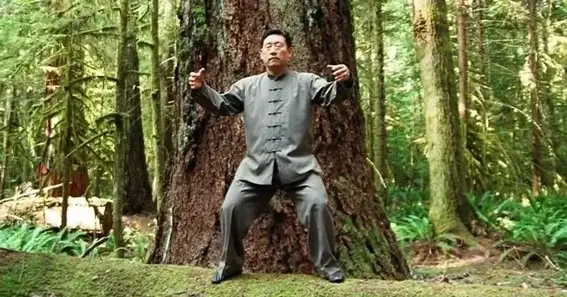In Chi Gung (Qigong), one of the most powerful and meditative postures is the “Stand Like a Tree” stance, also known as Zhan Zhuang. Practiced for centuries in China, this posture aims to cultivate internal energy (Qi), enhance body strength, and create deep relaxation. The goal is to emulate the stability and rootedness of a tree, while energy flows through your body, promoting health and vitality. Practitioners experience both mental and physical benefits through regular practice of this technique.
Rules for Practicing “Stand Like a Tree”
- Posture Alignment
Stand with your feet shoulder-width apart, knees slightly bent, and body relaxed. Ensure your weight sinks down into your feet, particularly at the “bubbling well” point (the hollow below your upper foot pad). The spine should be straight without force, and the arms positioned as if you are holding a large, invisible ball at chest height. - Breathing
Inhale deeply through the nose, allowing energy to rise from the earth, and exhale through the mouth to release tension. Focus on natural breathing, sometimes referred to as “embryonic breathing,” allowing energy to flow smoothly from your lower abdomen (Dantian). - Relaxation
Relax your muscles and focus on removing unnecessary tension from your body. The process involves a continuous balance between tension and relaxation, and over time, you will be able to hold the posture for longer periods as your body adapts. - Mental Focus
Keep your mind calm and clear. It’s important to practice mindfulness, focusing on the flow of energy throughout your body. Avoid distractions by gently returning your thoughts to the posture and breathing. - Gradual Progression
Start by holding the pose for a few minutes and gradually extend your practice time as you become more comfortable. Aim to increase the depth of your stance and the duration of each session for maximum benefit.
Also Read N: What Does A Studio Chart For Cello Look Like?
FAQ
1. What is the purpose of the “Stand Like a Tree” posture?
The purpose of this posture is to cultivate internal strength, balance, and energy flow (Qi) while promoting relaxation and mental clarity.
Also Read P: Should You Buy A Ford Mach-E Lemon? Here’s What You Need To Know
2. How long should I practice “Stand Like a Tree”?
Beginners should start with 5–10 minutes and gradually increase the time as they build endurance and flexibility, aiming for 15–20 minutes over time.
3. Can anyone practice Zhan Zhuang?
Yes, it’s suitable for all fitness levels, though it’s important to listen to your body and avoid pushing through pain. Consulting a professional is advised if you experience discomfort.
4. What should I focus on during practice?
Focus on your breathing, posture alignment, and mental clarity. Visualize energy flowing through your body as you maintain the posture.
5. Is there a specific breathing technique for “Stand Like a Tree”?
Yes, it’s recommended to practice deep, natural breathing from the lower abdomen, known as “embryonic breathing,” which helps promote Qi flow throughout the body.










